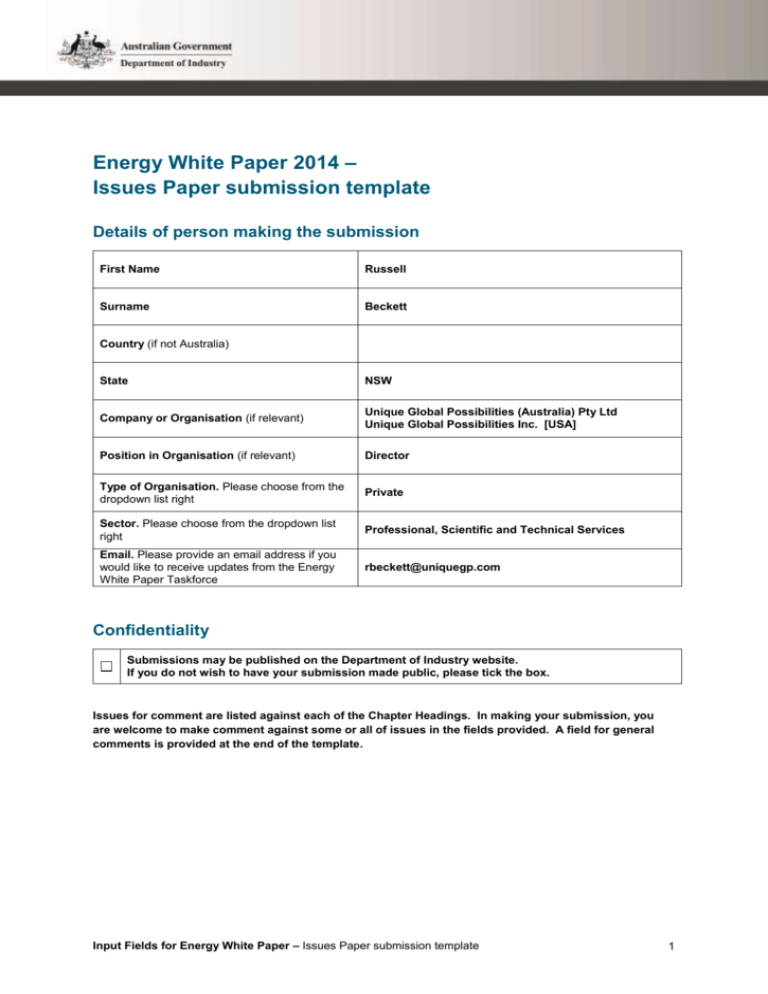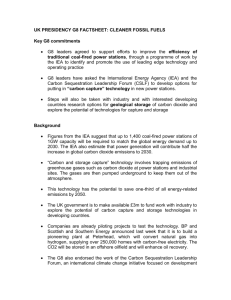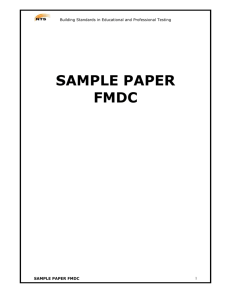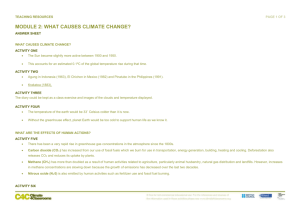Energy White Paper 2014 * - Department of Industry website
advertisement

Energy White Paper 2014 – Issues Paper submission template Details of person making the submission First Name Russell Surname Beckett Country (if not Australia) State NSW Company or Organisation (if relevant) Unique Global Possibilities (Australia) Pty Ltd Unique Global Possibilities Inc. [USA] Position in Organisation (if relevant) Director Type of Organisation. Please choose from the dropdown list right Private Sector. Please choose from the dropdown list right Professional, Scientific and Technical Services Email. Please provide an email address if you would like to receive updates from the Energy White Paper Taskforce rbeckett@uniquegp.com Confidentiality Submissions may be published on the Department of Industry website. If you do not wish to have your submission made public, please tick the box. Issues for comment are listed against each of the Chapter Headings. In making your submission, you are welcome to make comment against some or all of issues in the fields provided. A field for general comments is provided at the end of the template. Input Fields for Energy White Paper – Issues Paper submission template 1 1. The Security of Energy Supplies The Government seeks comment on: ways community expectations can be better understood and reflected in reliability standards; the value of developing fuel reserves to meet Australia’s international oil security obligations, and augment domestic security; ways to increase new gas sources to meet demand and measures to enhance transparency in market conditions; and issues relating to the regulation of energy infrastructure. Please provide any comments on The Security of Energy Supplies below: The submission by Unique Global Possibilites (Australia) Pty Ltd relates to a way of providing energy security by improving the use of new gas sources and current gas and coal sources to meet the demands of industry while decreasing costs and decreasing carbon dioxide (greenhouse gas) emissions. For details see General Comments. 2. Regulatory Reform and Role of Government The Government seeks comment on: priority issues, barriers or gaps within the COAG energy market reform agenda; possible approaches and impacts of review of tariff structures including fixed network costs, further time-ofuse based electricity tariffs and the use of smart meters; possible measures to promote greater price transparency in gas markets; and areas where further privatisation of government-owned assets would contribute to more effective regulatory frameworks and better outcomes for consumers. Please provide any comments on Regulatory Reform and Role of Government below: No comment. Input Fields for Energy White Paper – Issues Paper submission template 2 3. Growth and Investment The Government seeks comment on: commercial or market initiatives that could enhance growth and investment in the energy and resources sectors; areas where approvals processes could be further streamlined while maintaining proper environmental and social safeguards; further ways that regulatory burdens could be reduced while maintaining appropriate levels of disclosure and transparency in energy markets; and the impacts of variable land access policy and ways the community could be better informed and engaged on development in the energy sector. Please provide any comments on Growth and Investment below: The submission by Unique Global Possibilites (Australia) Pty Ltd relates to a way of enhancing growth and investment in the energy sector while decreasing costs to the end users of energy and decreasing carbon dioxide (greenhouse gas) emissions. For details see General Comments. 4. Trade and International Relations The Government seeks comment on: how to grow the export of value-added energy products and services; ways to remove unnecessary barriers to continued foreign investment in Australia’s energy sector; ways to strengthen support for access to export markets; and ways to support business to maximise export opportunities for Australia's energy commodities, products, technologies and services, including the value of Australia’s participation in the variety of international forums. Please provide any comments on Trade and International Relations below: The submission by Unique Global Possibilites (Australia) Pty Ltd relates to a way of supporting business and maximising export opportunities by decreasing energy costs to industry. It is possible that engineering industries that have been associated with component manufacture for General Motors and Ford in South Australia and Victoria could become associated with component manufacture for energy infrastructure. For details see General Comments. Input Fields for Energy White Paper – Issues Paper submission template 3 5. Workforce Productivity The Government seeks comment on: the nature of any current skills shortages being experienced and how these could be addressed by and with industry; the capacity of industry and education sector-led programs to meet long-term training and skills development needs of the energy and resources sectors; and specific long-term training and skills development needs for alternative transport fuel, renewable energy, energy management and other clean energy industries. Please provide any comments on Workforce Productivity below: No comment. 6. Driving Energy Productivity The Government seeks comment on: the current suite of energy efficiency measures, ways these could be enhanced to provide greater energy efficiency or possible new measures that would enhance energy productivity; the use of demand-side participation measures to encourage energy productivity and reduce peak energy use; and measures to increase energy use efficiency in the transport sector. Please provide any comments on Driving Energy Productivity below: The submission by Unique Global Possibilites (Australia) Pty Ltd relates to a way of providing new measures that enhance energy productivity. For details see General Comments. Input Fields for Energy White Paper – Issues Paper submission template 4 7. Alternative and Emerging Energy Sources and Technology The Government seeks comment on: ways to encourage a lower emissions energy supply that avoids market distortion or causes increased energy prices; the need to review existing network tariff structures in the face of rapidly growing deployment of grid-backedup distributed energy systems, to ensure proper distribution of costs; additional cost-effective means, beyond current mandatory targets and grants, to encourage further development of renewable and other alternative energy sources and their effective integration within the wider energy market; how the uptake of high efficiency low emissions intensity electricity generation can be progressed; any barriers to increased uptake of LPG in private and commercial vehicles and CNG and LNG in the heavy vehicle fleet; and any barriers to the increased uptake of electric vehicles and advanced biofuels. Please provide any comments on Alternative and Emerging Energy Sources and Technology below: The submission by Unique Global Possibilites (Australia) Pty Ltd relates to a way of encouraging a lower emissions energy supply that avoids market distortion or causes increased energy prices. It is possible to lower carbon dioxide emissions from fossil fuel combustion by more than 10 per cent for negligible cost. It is possible to lower carbon dioxide emissions further if carbon dioxide is perceived as an asset. For details see General Comments. General Comments Any further comments? The submission by Unique Global Possibilities (Australia) Pty Ltd relates to meeting community expectations for security of energy supply, lower energy costs and decreased carbon dioxide (greenhouse gas) emissions. The submission by Unique Global Possibilities (Australia) Pty Ltd relates to utilising carbon dioxide emissions from fossil fuel (coal and gas) combustion to produce either hydrogen or methane (natural gas) economically for use as further energy sources. Carbon dioxide emissions become an asset. The submission by Unique Global Possibilites (Australia) Pty Ltd relates to a way of producing hydrogen economically using fossil fuel carbon dioxide emissions. The hydrogen produced can be blended into natural gas pipeline networks or used to produce methane (natural gas) from further fossil fuel carbon dioxide emissions (utilising the well-known Sabatier or methanation reaction). There are multiple uses for hydrogen per se as a non-polluting energy source, including a non-polluting energy source for motors and motor vehicles. Large quantities of hydrogen can be produced economically utilising carbon dioxide emissions from fossil fuel combustion to split water into protons and hydroxide ions. That is, carbon dioxide facilitates Input Fields for Energy White Paper – Issues Paper submission template 5 (catalyses) the splitting of water (to produce so-called 'carbonic acid'). Under moderate pressure, protons are produced in relatively high concentrations and can be converted to hydrogen gas using very low voltages provided by renewable energy sources such as wind or solar energy sources. The water required to provide protons can be sourced from many sources including recycled or reclaimed water (such as stormwater or sewerage) provided by local councils or other utilities and industries. Hydrogen produced by the above process can be added directly to existing natural gas pipelines. Blending hydrogen into natural gas pipeline networks is a well-known procedure which has the advantage of decreasing carbon dioxide emissions because hydrogen combusts to water and absolutely no carbon dioxide is produced in the combustion. See the US Department of Energy's National Renewable Energy Laboratory Technical Report titled: 'Blending Hydrogen into Natural Gas Pipeline Networks: A review of Key Issues', March 2013. [www.nrel.gov/docs/fy13osti/51995.pdf] Blends into natural gas exceeding 10 per cent hydrogen are possible with existing infrastructure and end-user equipment. Hydrogen blending occurs currently in Hawaii (up to 30 per cent) and Europe (up to 15 per cent). Historically, town gas of the nineteenth and early twentieth centuries contained 50 per cent hydrogen. Decreases in carbon dioxide emissions are correlated closely to the percentage of hydrogen blending because less natural gas is being combusted for energy produced. Splitting water utilising carbon dioxide emissions from fossil fuel combustion to form protons is an economic means of producing hydrogen. The electrons needed to convert protons to hydrogen are derived from renewable energy when available. The costs of hydrogen production are decreased considerably compared to standard electrolysis and other means. The hydrogen can be reacted further with carbon dioxide emissions to form methane (the Sabatier reaction). Much work has been completed throughout the world researching ideal conditions for the production of methane in the Sabatier reaction. For example, see abstract of published article: 'Carbon dioxide recycling by reaction with renewably generated hydrogen', January 2010. [http://www.sciencedirect.com/science/article/pii/S1750583609001005] In industrial facilities using natural gas, a semi-closed chemical loop can be formed: methane-carbon dioxide-methane using renewable sources of energy. In these semi-closed loop reactions, very little external water is required because methane combustion produces water. It is possible that methane production on-site, using renewable energy to produce large quantities of hydrogen and then reacting hydrogen with carbon dioxide emissions, may eventually stabilise the price of natural gas, coal and electricity. Carbon dioxide and hydrogen react in the gaseous phase to produce methane which avoids expensive carbon dioxide capture, transport and geologic sequestration. One solution to two problems - carbon dioxide (greenhouse gas) emissions and inherently variable renewable energy sources - is to develop a non-polluting source of stored energy, such as hydrogen, which can be produced economically from carbon dioxide emissions. Methane may also be produced by reacting the hydrogen with carbon dioxide emissions and greenhouse gases are decreased further. Both methane and hydrogen may be stored, added to existing natural gas pipelines or used directly onsite. Unique Global Possibilities has described a process that provides a solution to the above problems of carbon dioxide emissions from fossil fuel combustion and variable renewable energy sources. For more detailed information about the process see the Commercial Energy Research section of the Unique Global Possibilities Inc. website [www.uniquegp.com]. Large reductions in carbon dioxide emissions (by utilising carbon dioxide as above) coupled with an economic source of hydrogen or methane (as above) enhances Australia's political and international reputation for decreasing greenhouse gases while assisting in providing a cheap source of energy for industry. For further technical information contact the Research Director, Dr R Beckett: rbeckett@uniquegp.com. Input Fields for Energy White Paper – Issues Paper submission template 6






